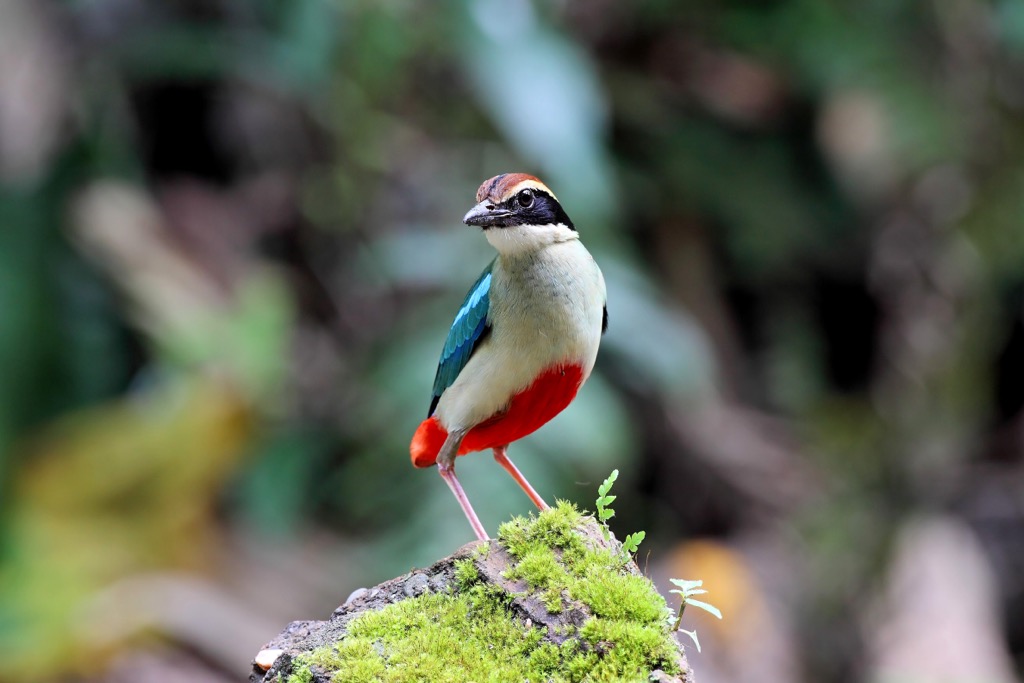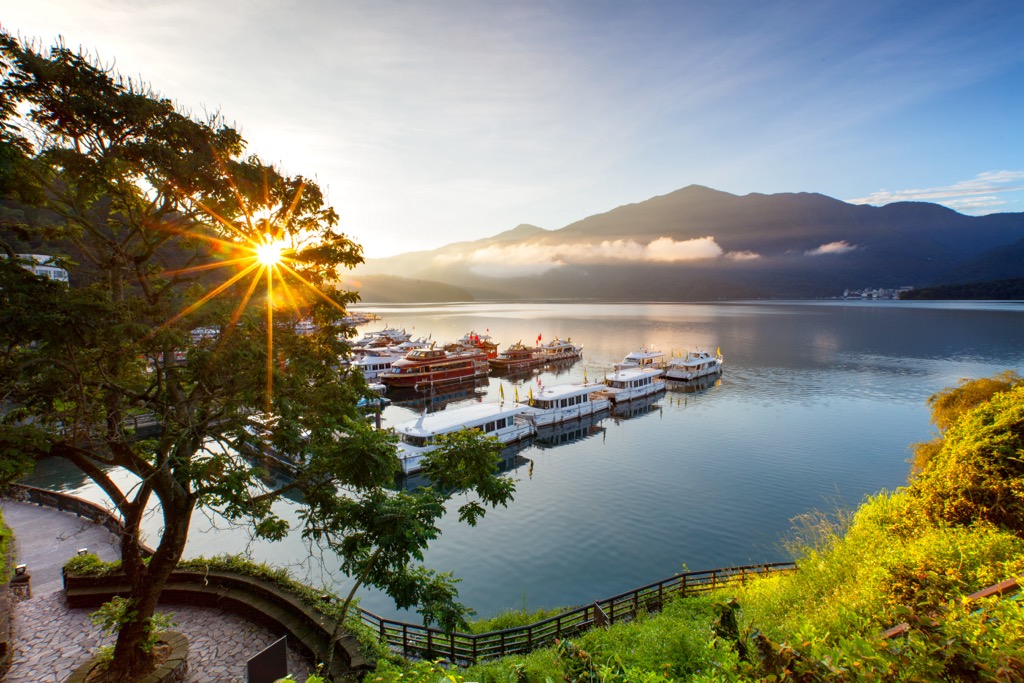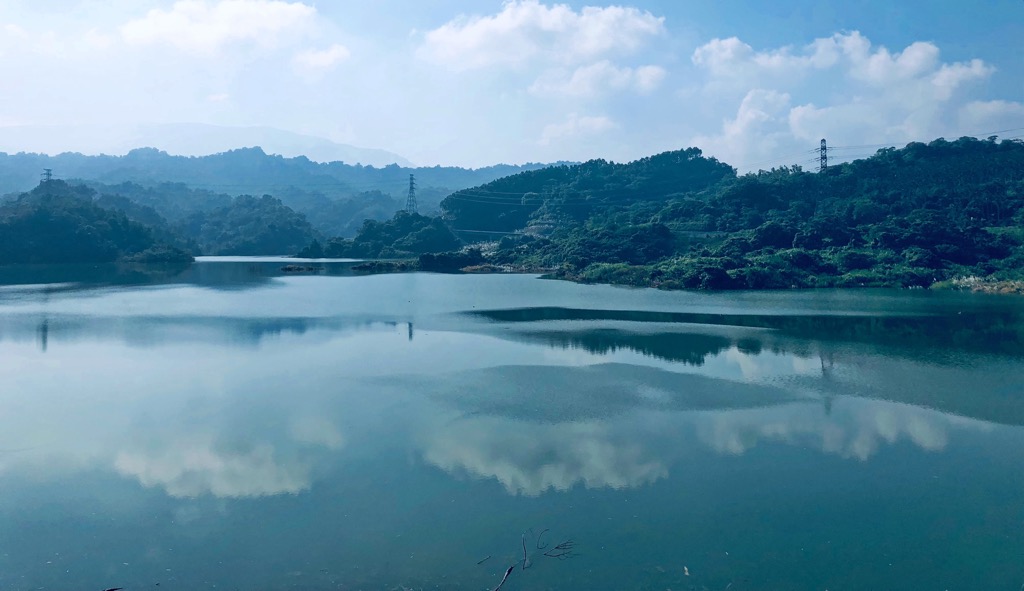Get PeakVisor App
Sign In
Search by GPS coordinates
- Latitude
- ° ' ''
- Longitude
- ° ' ''
- Units of Length

Yes
Cancel
Share ×

Scan the QR code and open PeakVisor on your phone
❤ Wishlist ×
Choose
Delete
Yunlin County (雲林縣) has a fertile piece of land surrounding Hushan Reservoir (湖山水庫), where the eight-colored bird species thrive. This hilly sanctuary in central Taiwan comprises 6 named peaks. The highest and most prominent peak is Chukoushan (觸口山), measuring 332 meters (1,089 ft).

Yunlin Lake’s Important Habitat for the Eight-Colored Bird (雲林湖本八色鳥野生動物重要棲息環境) covers 1,737 ha (4,292 ac) of land. This bird sanctuary lies inland, bordering Nantou County (南投縣) to the east and north, while to the northwest rests Changhua County (彰化縣).
Taiwan’s rare eight-colored bird is a migratory species that flock to Yunlin County’s Huben Village (湖本村). According to the ICUN red list, the otherwise-known fairy pitta or Pitta nympha lists as vulnerable. Thus, they remain safe in Yunlin County’s remote hillside.
The low-elevation forest thrives in the humid subtropical environment with an annual average temperature of 73°F (23°C). Yearly rainfall of 2,000 mm (79 in) aids plant growth in the fertile land. Thus, the leafy vegetation, combined with the low human population, is a perfect setting to nurture the decreasing bird species.
Being a hilly terrain, the other hills in the environment are Nanchukoushan (南觸口山), Yangzikenghshan (樣子坑山), and Linnei Shan (林內山).
As Yunlin Lake’s Important Habitat for the Eight-Colored Bird is in a lesser-known region, it may help to locate more popular places surrounding it. Sun Moon Lake (日月潭), one of Taiwan’s most scenic sites, lies northeast, while Alishan Forest (阿里山國家森林遊樂區) is in the southeast. To the west is Yunlin County’s coast, where the Taiwan Strait flows. While Changhua’s Bagua Mountains lie to the north.
Yunlin Lake’s hills belong to the northern branch of the Alishan Range (阿里山山脈). Being Taiwan’s second smallest mountain range, these gentle, shallow peaks comprise shale and sandstone from the Miocene to Pleistocene epochs.
While in the low-lying plains, the topsoil is thin and a mix of alluvial combinations with an intermingling of red loam.
Yunlin Lake’s terrain is afforested, with low-elevation broad-leaf trees, such as camphor, acacia, and teak. A thriving shrubbery of hemp, osmanthus and green bamboo also flourishes in the environment, plants that sustain birdlife.
There have been up to 159 recorded sightings of the eight-colored bird in Yunlin Lake’s woods. Other bird species that inhabit the verdant land are the Swinhoe’s pheasant, Taiwan purple howling bird, and the Mikado pheasant.
Yunlin Lake’s Important Habitat for the Eight-Colored Bird was established in 2008 when researchers found the vulnerable bird species in the area. The region is rural and remote, so the eight-colored bird remains safe from human interference.
However, villagers had to oppose government plans to preserve Yunlin Lake’s precious bird sanctuary in earlier years. In 1988, mining plans were agreed upon at government level near Huben Village but were withdrawn after conservations voiced their dissatisfaction.
Another incident occurred in 1999 when local officials granted the proposal to collect rocks from Yunlin Lake’s mountains to construct a school. The community once again protested against interfering with nature, and their efforts were recognised and rewarded.
The major hiking trails and areas in and around Yunlin Lake’s Important Habitat for the Eight-Colored Bird are:
One of Yunlin County’s most scenic nature trails is at Hushan Reservoir. Situated south of the Yunlin Lake’s region, the path’s terrain gently undulates up a small hill and dips into the valley. It is a beautiful 4 km (2.5 mi) walk around Taiwan’s ninth-largest reservoir.
Hiking Hushan Reservoir is a meditative wonder. You’ll feel instantly calmed by the peaceful setting of the turquoise pond and vibrant forest. Pheobe and ficus trees flourish in the environment, as do rare plants, rock begonia and deer valley begonia.
At the trail’s highest point, on Yangzikengshan, you’ll overlook the Hushan Reservoir as well as Douliu City (斗六市) in the distance. The still reservoir water mirrors the heavenly Taiwan sky like a radiant pearl.
You can trace the mountain ridge from Linneishan to Chukoushan on the 4.2 km (2.6 mi) Longgoumai Forest Trail (龍過脈森林步道). Named after a crouching dragon drinking water, the route is bumpy and rocky like the back of the firebreathing animal.
Revel in the tranquil outdoors of this leafy wonderland. The path undulates throughout the broadleaf woodlands as you enter the damp, shaded jungle and rise towards the open clearings.
You may spot Taiwan macaques along the path and see the purple-spotted butterflies flitter across your route. In addition, you may hear the eight-colored bird singing in the trees, and hopefully, you can spot its magnificent rainbow colors.
You can view Changhua’s Bagua Mountain passage run northwards through the open clearings and Yunlin’s southern peaks extending towards Alishan.
Situated north in Nantou County is the prominent Tea Fragrance Trail (茶香步道). There is a delineated path for visitors to walk and appreciate the sights and smells of the pine and cypress evergreen tea plantation.
While the elevation is not high, these temperate trees grow on the farmlands, producing leaves for the brew. Enjoy a leisurely stroll along the gentle path of the tea garden. You’ll see farm laborers picking tea leaves while you inhale the sweet tea aroma carried by the breeze.
As the tea plantation is rural, you’ll notice immense greenery surrounding the fields. Tanaka Forest Park and the leafy Songbai Ridge are both visible from the path. After your scenic wanderings, you can stop and sample the speciality tea onsite as a welcome treat.
If you smell the awakening aroma of coffee, you’re in the right place. Situated south of Yunlin Lake’s Important Habitat for the Eight-Colored Bird, arabica beans thrive in plantations on Heabaoshan’s (荷苞山) hillside meadows. For this reason, it is known as Coffee Mountain.
While the interest in coffee might attract you to this trail, it's particularly beautiful in springtime when milky tung blossoms contrast against the vibrant greenery. Farmers planted tung trees to aid the growth of arabica beans shipped from Africa. Other flowers that bloom on the hill are magnolias, peach blossoms, and hibiscus.
Along the course, you can view Douliu City below to the south. A visit to Hebaoshan is incomplete without a welcoming cup of coffee to perk you up and start your day right.
Situated further south of Yunlin Lake’s Important Habitat for the Eight-Colored Bird is Dajianshan Hiking Trail. Straddling the border of Yunlin and Chiayi counties, this hill overlooks both rural lands from its high elevation.
Being closer to Alishan, Dajianshan (大尖山) measures 1,305 meters (4,281 ft), a significant difference from Yunlin Lake’s shallow hills. Many climbers flock to the summit at sunrise and sunset as the outlooks onto Taiwan’s backcountry glow under the golden light. You can see as far as Yushan (玉山), Taiwan’s highest hill, and Alishan Forest’s peaks.
Nantou County’s alpine lake is one of Taiwan’s most picturesque settings. Situated closeby to Yunlin Lake’s Important Habitat for the Eight-Colored Bird, Sun Moon Lake is a popular getaway both for locals and tourists for its stunning scenery.

Blue misty mountains border the 793 ha (1,960 ac) turquoise lake. There are many trails for you to hike to admire different perspectives of the tranquil pond. At night, strings of lakeside lights mirror against the water, creating a magical sight. During the day, you can take a boat trip to the lake to enjoy the stunning landscape.
You can also head to the Formosan Aboriginal Cultural Village (九族文化村) to wander through the open-air museum, taste some native Taiwanese treats, and take to the thrilling theme park rides.

As Yunlin Lake’s Important Habitat for the Eight-Colored Bird is in a remote region, no huge urban centres are near the sanctuary. You can enjoy the quiet side of Taiwan in the smaller, more intimate cities that seem more like sleepy towns. Douliu City of Yunlin County and nearby Nantou City are two great options.
A beautiful blend of small-town hospitality and slow living, Douliu City is hypnotic in its mellow yet still vibrant city life. One major drawcard is it's surrounded by nature, so you’re never too far to explore the emerald landscape.
One of Douliu City’s popular attractions is its Janfusan Fancy World (劍湖山世界主題樂園) theme park. There are many rides and some roller coasters at the playground to test your nerves of steel. You can also splash at the water park and whoosh on the flumes and water slides for a day of fun. You’ll have an entertaining time at Janfushan Fancy World in the gloriously sunny Taiwan weather.

Next, head back to nature and walk along the tree-lined Yunlin Road (雲林路). Nearby are the wooden Japanese-built dormitories of historical interest. Once housing Japanese police officers, they’re now coffee shops and trendy boutiques that still retain their well-preserved wooden exteriors. Locals love to visit here during the weekend, so you’ll surely be met with many smiles on a Saturday or Sunday.
Then, experience Douliu’s evening charm at Douliu Zhuangjing Night Market (斗六莊敬夜市). Frequenting a night market is an absolute must when visiting Taiwan, and it's a great way to compare bustling hubs with smaller cities. While Douliu’s market size may be smaller, it's just as vibrant with cajoling vendors, sizzling food, and lingering aromas. Foods to sample are sweet potato balls, xiaolongbao, and Yamamoto steaks.
Taiwan’s largest inland city is a fantastic base if you want to uncover Taiwan’s rampant backcountry. It’s a short drive to scenic Sun Moon Lake and other enchanting forests and areas.
Nearby Aowanda Forest (奧萬大國家森林遊樂區) is a haven of birdlife and abundant maple woodlands. Visit in autumn for the crimson display of honey-colored leaves. Hike the many trails through the thriving groves and the gentle hills for a mesmerizing day in nature.
Another one of Nantou County’s outdoor escapes is Huisan Forest Area (惠蓀林場). Known for its untouched beauty, many botanists and researchers conduct studies here. Revel in Huisan Forest’s lush exuberance with its wild plant life of subtropical and temperate trees. The terrain dips into valleys and rises up hills, creating a scenic path to view its verdant area.
Finally, head to Xitou Nature Education Area (溪頭自然教育園區). You can birdwatch in the quiet woodlands, as 7,000 bird species inhabit the area. As the flora is diverse, there are bamboo forests, red cypress and ginkgo trees. Get lost in the dense bamboo grove where sunlight hardly reaches. For a beautiful sight, head over the bamboo bridge over Daxue Pond.
Take the local express train (TRA) to Douliu City from any of Taiwan’s major cities. Once in Douliu, change platforms and board the train to Linnei Station. Yunlin Lake’s Important Habitat for the Eight-Colored Bird is a 10-minute walk from the station, following the signs to the Longgoumi Hiking Trail.
Alternatively, you can drive 10.6 km (6.5 mi) to Yunlin Lake’s Important Habitat for the Eight-Colored Bird from Douliu City
Explore Yunlin Lake’s Important Habitat for the Eight-Colored Bird with the PeakVisor 3D Map and identify its summits.




